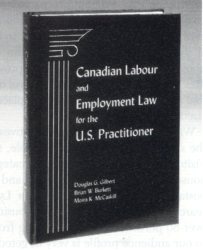I |
f they look alike, smell alike, sound alike, then they must be the same, right? Not exactly. Though Canada and the United States are similar in many ways, they are not identical, especially when it comes to labor laws. Bentonville, Ark.-based Wal-Mart found that out the hard way.
After entering the Canadian marketplace about 10 years ago, Wal-Mart became the subject of a union organizing campaign in Windsor, Ontario. The provincial labor board conducted a vote, and though the resulting 79 percent decision against unionization was enough to end the campaign, the organization team took it a step further saying that Wal-Mart had conducted unfair labor practices. What had Wal-Mart done that was so offensive?
It sent store managers out to talk about the union with whoever was willing to talk — a practice that had worked well for the company in the States. And when asked by employees if the store would close if a union came in, the managers would not respond. For Wal-Mart, which has a culture of responding to employee questions rather quickly, the lack of manager response was the same as a resounding “Yes.” The labor board found Wal-Mart’s conduct to have undue influence on the vote outcome, and using Ontario’s labor law at the time, the board certified the unionization.

“This shows that when a company like Wal-Mart, which remains non-union across the United States, gets organized in its early days in Ontario, there is a different law and a different standard that is being applied,” said Douglas G. Gilbert, a labor lawyer with Heenan Blaikie, Ontario, at a Canadian labor seminar held in Atlanta in February. “In this case, and unfortunately in many others, the employer wasn’t sufficiently mindful of the distinctions, and the situation could have been avoided.”
Wal-Mart eventually fought off the union, but it took many years in court and lots of hard bargaining.
Primary Concerns for U.S. Employers
Unionization is one of two labor issues with which U.S. companies are most concerned when entering Canada, noted Gilbert; the other is the individual employment relationship (this topic will be discussed in the September issue of Site Selection). The unionization process in Canada works differently than in the United States.

Gilbert reports that in five of the nine provinces union certification is achieved by the fair card check process. The union signs up a majority of employees, submits its application for certification to the provincial labor board, and if the union demonstrates that it has the majority required by law, it will be certified without a vote. Much of this process can occur before the employer is made aware.
In recent years, Ontario has changed its program to require a vote be conducted for every unionization application, allowing the employer to launch a counter-campaign. The vote is held within five days of the application.
“Five days is a short period for an employer to conduct a counter-campaign,” Gilbert explained. “But things can be done, and we find successfully done, because in a high number of cases people do change their minds.”
which was released last December, to help U.S. companies understand the nuances of Canadian labor law.
There are restrictions to what an employer can do. They cannot pose threats or make promises of a positive outcome if the union is rejected. Captive audience meetings, one-on-one meetings and putting a senior executive in front of a group of employees would also be seen as excessive. Employers can, however, respond to propaganda used by the union and explain its preference to remain and the benefits of being non-union.
“Even with the restrictions, the important thing is to get into the heads of the employees,” said Gilbert. “That can be done equally effectively under our laws as it can be under the U.S. laws.”
American companies have an advantage in Canada that they would not have in the States. Employers can establish employee committees in a non-union context. Though these committees cannot be formed during the heat of an organizing campaign, they can be developed prior to organization and be maintained during the process.
Heenan Blaikie worked with a large automotive manufacturer that had been the subject of three organizing campaigns. All three times the union lost the vote “largely because the company has a very strong committee structure, and it’s able to stay in touch even during these moments of stress through the committees,” Gilbert says.
Such success stories can be achieved in Canada, said Gilbert, if international companies locating in the country will take the time to understand the labor laws. “Canada is not Georgia, but it’s not Sweden either,” said Gilbert. “It’s a jurisdiction that you can work in if you’re mindful of the distinctions.”

